Just when you found your way through the old form, they have designed a new maze to navigate.
Below, you will find all 16 pages of the new IEP form from the Connecticut State Department of Education. Click on the icons to get our tips and guidance for completing the form accurately and in the best interest of your child. Click again to close the pop-up.
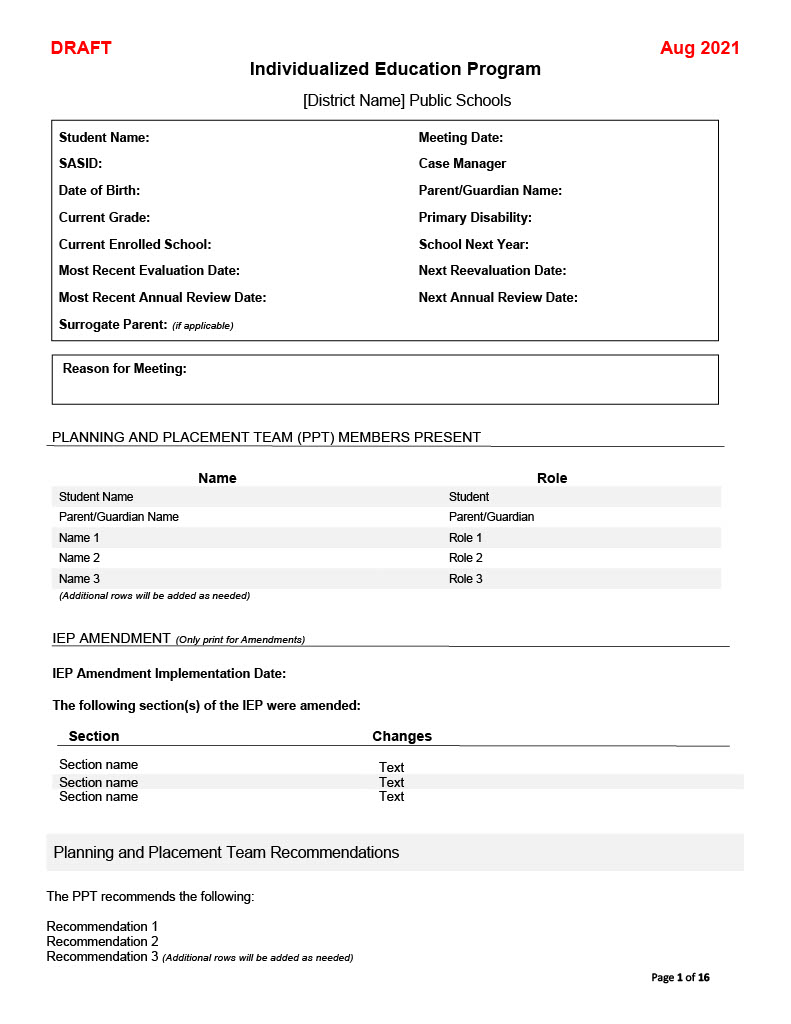
Welcome!
This year presents an exciting evolution in Connecticut's special education system. As of June 2022, the Connecticut Department of Education has transitioned to a new Individualized Education Program (IEP) structure. We're saying goodbye to IEP Direct and introducing CT-SEDS. Every student with an annual Planning and Placement Team (PPT) meeting—essentially, every student with an IEP—will be using this revamped framework.
As we adapt to this change, we'll explore the new layout together, familiarizing ourselves with its unique features and understanding what they mean for our students. Even though this change might seem daunting, remember we're in this together. Our commitment to providing the best educational experiences for our students remains steadfast. So, let's embrace this change, dive into CT-SPEDS, and continue our collective pursuit of effective and inclusive education for all.
Not so different.
Like simply turning the page of a good book, the first two sections of our new, improved IEP equate to what you've familiarly known as Page 1 in the old IEP - a fresh layout, but same valuable information.
This is the State Assigned Student Identifier
The SASID is a ten digit unique number that is assigned to each student upon entry into a Connecticut public school including publicly funded preschool programs as well as standard elementary, middle and high schools.
Disability Categories
The IDEA offers 13 Disability Categories but CT offers a few more. The options are no longer listed, making it important for you to acquaint yourself with each one to effectively advocate for your child's needs. The Primary Disability Categories you can use in CT are:
It's like learning a new language to better communicate and advocate for your child's education. Remember, you've got this!
Current Enrolled School
This section of the IEP outlines the school district's proposed educational plan for your child. It does not reflect any current, alternate strategies you might be employing, like private programs or those set up through a settlement agreement. Essentially, it's the school's initial plan, regardless of any extra measures you've taken.
Next School Year
This section presents the school district's proposed educational program for your child. Hopefully, it aligns with your expectations and visions for your child's education.
Most Recent Evaluation Date
This section details the educational program originally proposed by your school district, not necessarily the one your child is currently participating in. If you've opted for a private program or are involved in a different arrangement (like a settlement agreement), this section will still reflect the original proposal of the school district, not the current 'alternative' program your child is attending.
Next Reevaluation Date
This part indicates when your child is due for a comprehensive re-evaluation of their needs, referred to as a 'triennial evaluation.' It's a vital component of their education process and happens at least every three years. However, it can be carried out earlier if necessary. This evaluation covers all areas of your child's disability.
Most Recent Annual Review Date
This section denotes when your child's most recent annual IEP meeting occurred. As we progress into the 2023-2024 academic year, your school will switch to the new IEP platform, CT-SEDS, starting from your next annual meeting. However, should there be other PPT meetings before this, they might still employ the previous form. As this transition is new to many school districts, your understanding and patience during this period of change are much appreciated.
Next Annual Review Date
This section denotes the latest date by which the next Annual IEP meeting should be convened. It's an important milestone in your child's academic progression. Remember, it's always possible to arrange a PPT meeting sooner if needed. But the Annual IEP meeting is a critical event that must occur on or before this specified date.
Surrogate Parent
This section relates solely to children in foster care. According to the Individuals with Disabilities Education Act (IDEA), a "Surrogate Parent" is appointed to advocate for the special education needs of these children. In Connecticut, these vital roles are fulfilled by independent contractors, who are hired, trained, and supervised by the Department of Education.
Reason for Meeting
The days of ticking boxes are behind us. It's important to note that Planning and Placement Team (PPT) meetings can be called for various reasons, which will be detailed in your PPT Notice. While the previous form allowed for a range of options to be visibly checked off, the new format doesn't provide the same visual. However, if multiple circumstances are applicable, they should all be enumerated:
- Review Referral
- Plan Evaluation/Reevaluation
- Review Evaluation/Reevaluation
- Determine Eligibility
- Determine Continuing Eligibility
- Develop IEP
- Review or Revise IEP
- Conduct Annual Review
- Transition Planning
- Manifestation Determination
Remember to keep these factors in mind when reviewing your notices, as they remain integral parts of the process.
Planning and Placement Team (PPT) Members Present
Great news everyone! Our educational platform now has ample space for all PPT participants! Now we can also make sure everyone's roles are correctly and clearly identified. This makes it easier for everyone involved in the process to understand their responsibilities and work together effectively.
IEP Amendment
This section is solely for amendments. If there's unanimous agreement on a change in the IEP, you can make an amendment without having to hold a PPT meeting.
However, if there's disagreement on the proposed amendment, a PPT meeting should be held. This allows you to voice your concerns formally and ensure they're part of the official record. Your input is crucial in shaping the best educational plan.
Recommendations
The "Summary" option is no longer part of this section. Now, we only have the "Team Recommendation," reflecting the school district's proposed plan, regardless of whether you agree with it or not.
Let's take a minutes to discuss what's NOT on this new IEP; the Summary and Prior Written Notice!
The Summary has been repositioned as an optional, separate document that schools can choose to complete. While it would be beneficial for it to be filled out, its completion is not guaranteed.
Parents have the opportunity to draft their own summaries and can request that these are attached to the IEP or, at the very least, retained in their child's educational file. This provides an additional channel for parent perspectives and concerns to be officially recorded and referenced in future discussions about their child's educational plan.
The Prior Written Notice is also now a separate document but it is NOT optional. You may or may not receive it with your IEP so keep an eye out for it and store it along side your IEP for future reference.
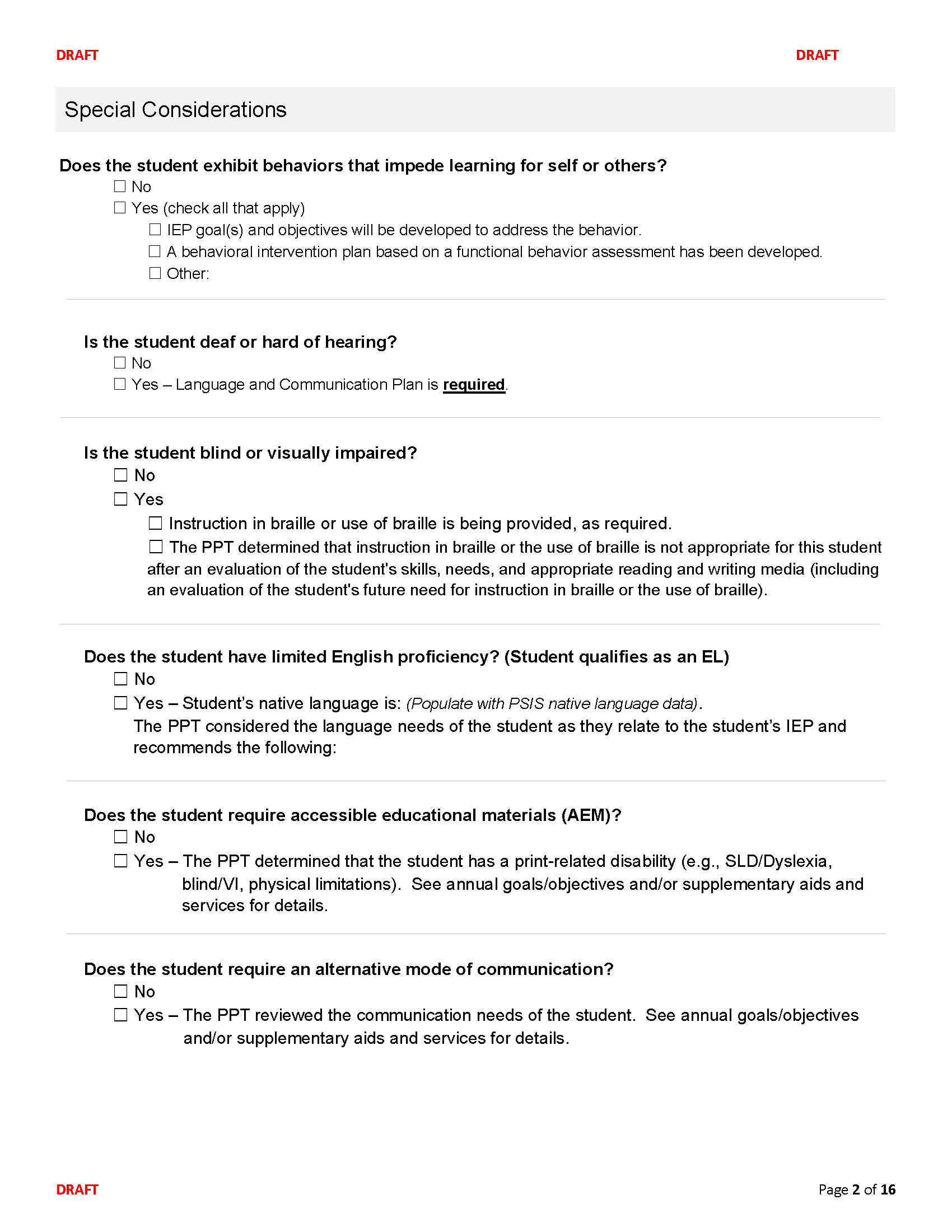
Special Considerations
Consider this section of the IEP as the tailored accommodations for your child. This section ensures that each student has the exact resources they need, considering their unique needs.
Functional Behavior Assessment (FBA)
A recent ruling from the Second Circuit Court of Appeals clarified that Functional Behavioral Assessments (FBAs), when conducted independently, do not equate to a comprehensive evaluation in terms of parents' rights to request an independent educational evaluation (IEE) at public expense. However, if an FBA is part of a comprehensive evaluation, it could potentially contribute to an IEE request. Different courts may interpret this differently, so keep abreast of future legal updates. D.S. v. Trumbull Board of Education, 120 L.R.P. 28133 (2d Cir. 2020).

Academic, Pre-Academic, Cognitive Achievement
The 'Academic, Pre-Academic, Cognitive Achievement' section of the IEP outlines your child's educational goals and short-term objectives, as well as the methods and schedule for tracking progress. Now, schools are required to align goals with CT Core Standards and specify the related services your child will need. The IEP now provides a more well-planned and enriching educational journey for your child.
Parent an Student Input
The new IEP now places the Parent and Student input at the beginning of each area of Goals and Objectives.
The Parent and Student concerns listed here should be those related to Academic, Pre-Academic, and Cognitive Achievement only.
SMART Goals and Objectives
Let's distill the essence of the SMART Goals and Objectives critical for our educational journey:
Specific: To increase the likelihood of achieving our goals, we must be clear about them. This means identifying who is involved, what we want to achieve, where and when it will happen, and why it's essential.
Measurable: It's crucial to have a way to measure progress. This involves setting key indicators that allow us to quantify our achievements and know when we've reached our goal.
Achievable: Our goals need to be realistic. We must ensure we have the skills and resources needed to achieve them.
Relevant: Our goals should align with the broader objectives of our educational journey and be realistic given market conditions.
Time-bound: Setting a deadline for achieving our goals creates urgency and allows us to schedule the necessary steps.
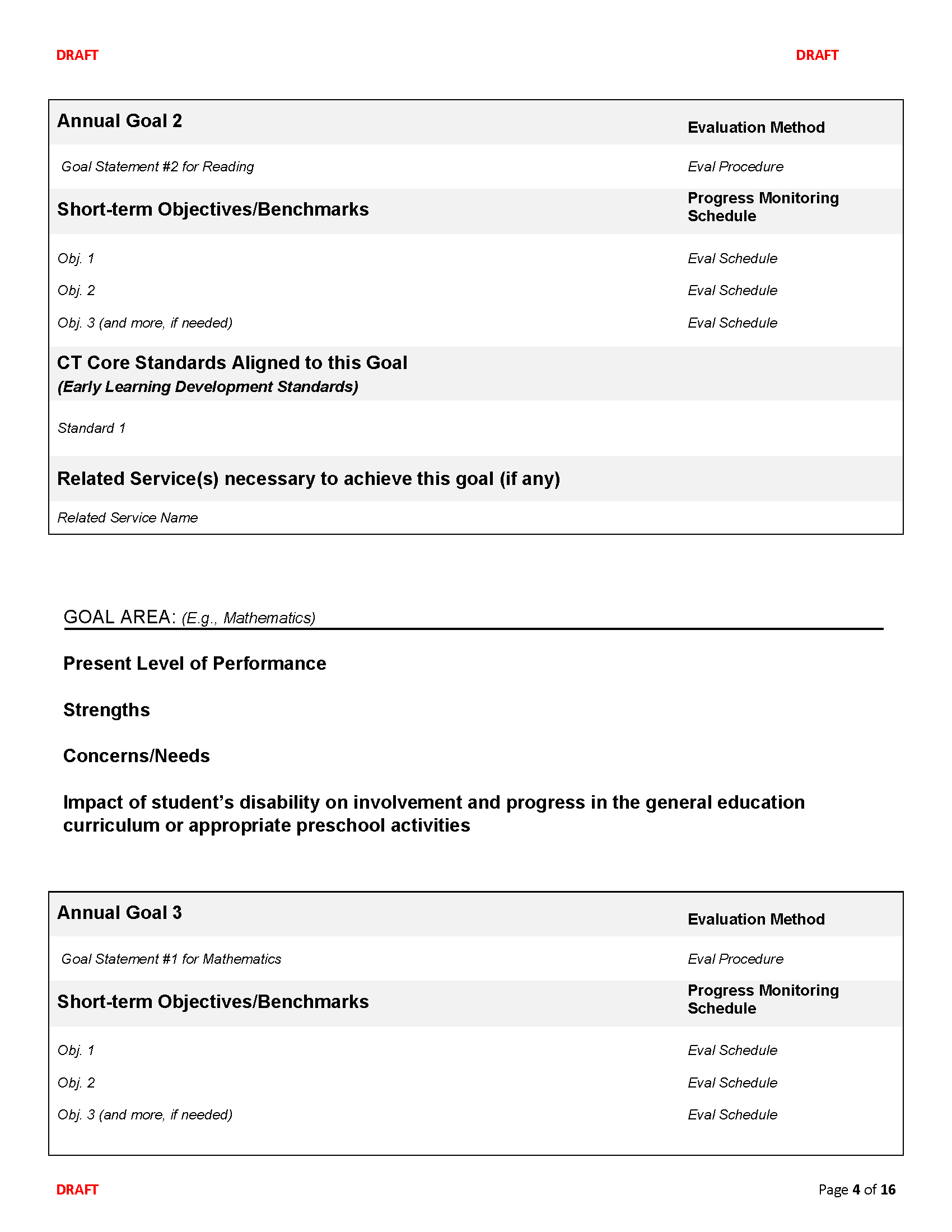
Goals & Objectives
Note that there is no limit to the number of Goals and Objectives your child can have on their IEP. Keep in mind, however, that these goals and objectives are expected to be met within one calendar year.
If they can't all fit into the daily schedule then your team should consider an extended day.
Goals and Objectives should never be dumbed down for the schedule of the school or the services providers.
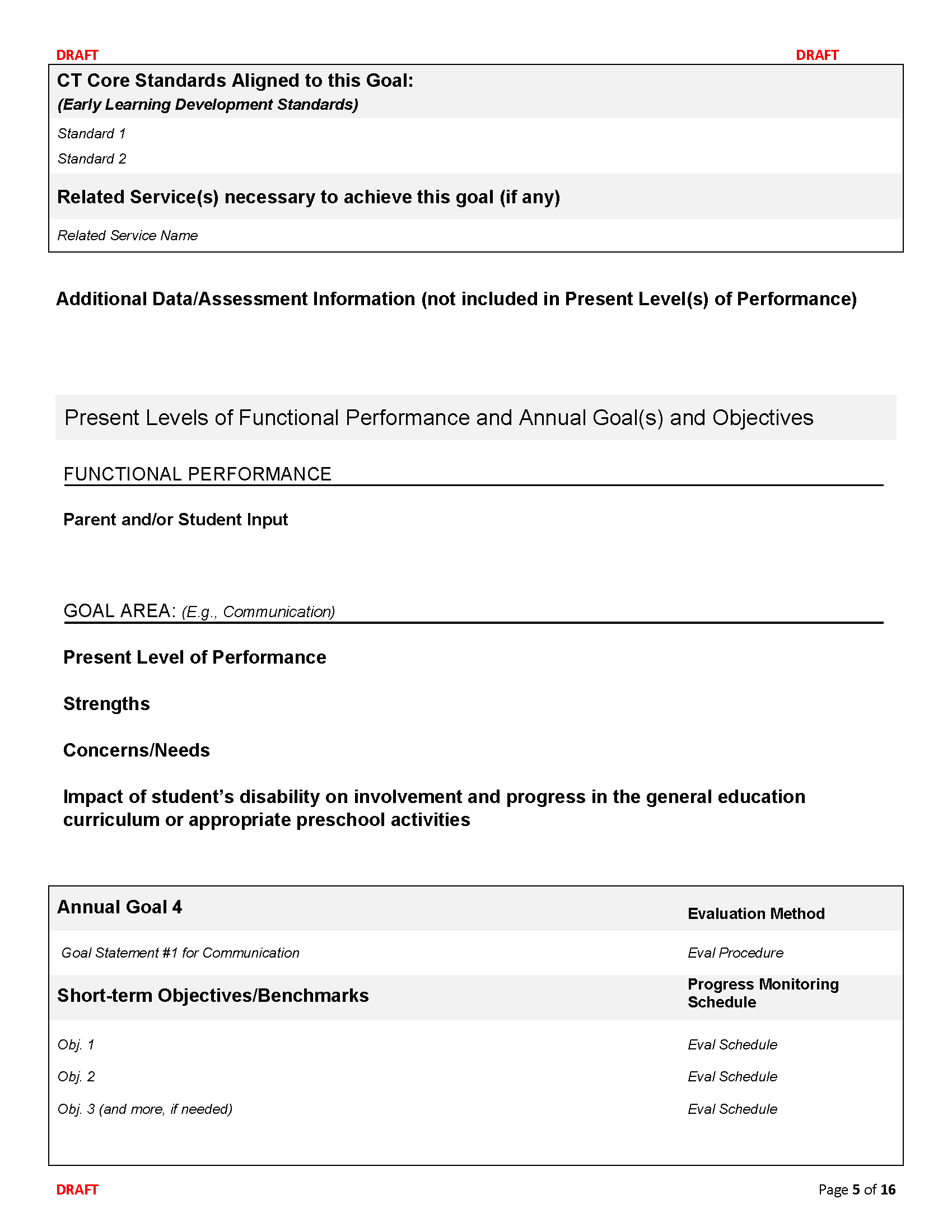
Functional Performance
This section of the IEP includes goals for skills essential in real life that may not be academic, like self-care, social skills, and vocational skills. These functional skills are vital tools that your child will need to navigate life outside the classroom.
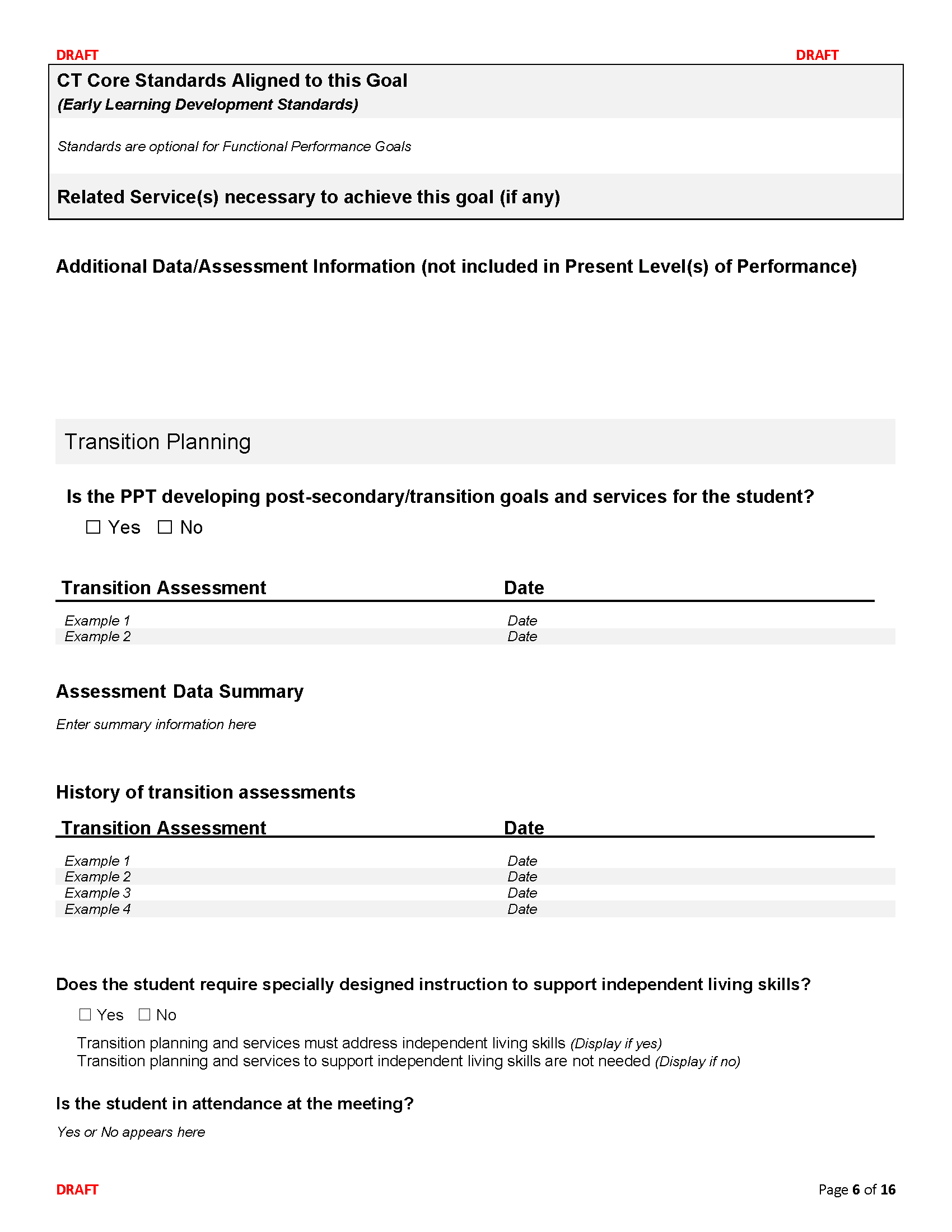
Transition Planning
At its core, the Transition Section of an IEP focuses on setting the stage for your child's life after high school. It's all about laying a strong foundation for the future – whether that entails attending college, pursuing vocational training, entering the workforce, or other avenues of personal and professional development.
By age 14
By law, transition planning must commence by the time your child turns 14, or earlier is appropriate. This proactive approach ensures ample time to tailor strategies and resources to your child's specific aspirations and needs.
Transition Assessments
As we navigate the expansive landscape of the IEP, one term you'll often encounter is 'Transition Assessments.' Let's dive into what this means, why it's essential, and how it works in tandem with the overall transition planning process.
What are Transition Assessments?
Transition assessments are structured tools or methods that help us understand your child's strengths, preferences, interests, and needs as they relate to post-secondary environments, including education, employment, and independent living. Think of them as a compass helping to guide our path towards effective transition planning.
Purpose of Transition Assessments:
Types of Transition Assessments:
There isn't a one-size-fits-all approach. Transition assessments come in various forms:
When are They Conducted?
Transition assessments are typically initiated before or during the onset of formal transition planning, which often starts by age 14, depending on state regulations. However, they're not a one-time event. Reassessments should occur periodically to accommodate the student's growth and changing aspirations.
Who's Involved?
While professionals administer the assessments, it's crucial to remember that the student plays a central role. Their feedback, reflections, and perspectives are invaluable. Parents, teachers, and other relevant professionals also contribute insights and information to ensure a comprehensive understanding.
Using the Results:
Once we have the results, they act as a foundation for drafting the transition section of the IEP. They inform the goals, services, and course of study that will best serve your child's post-secondary ambitions.
In essence, transition assessments are like a beacon, illuminating the way as we chart a course for a student's post-secondary journey. They ensure that every step we take is informed, purposeful, and aligned with your child's unique strengths and dreams.
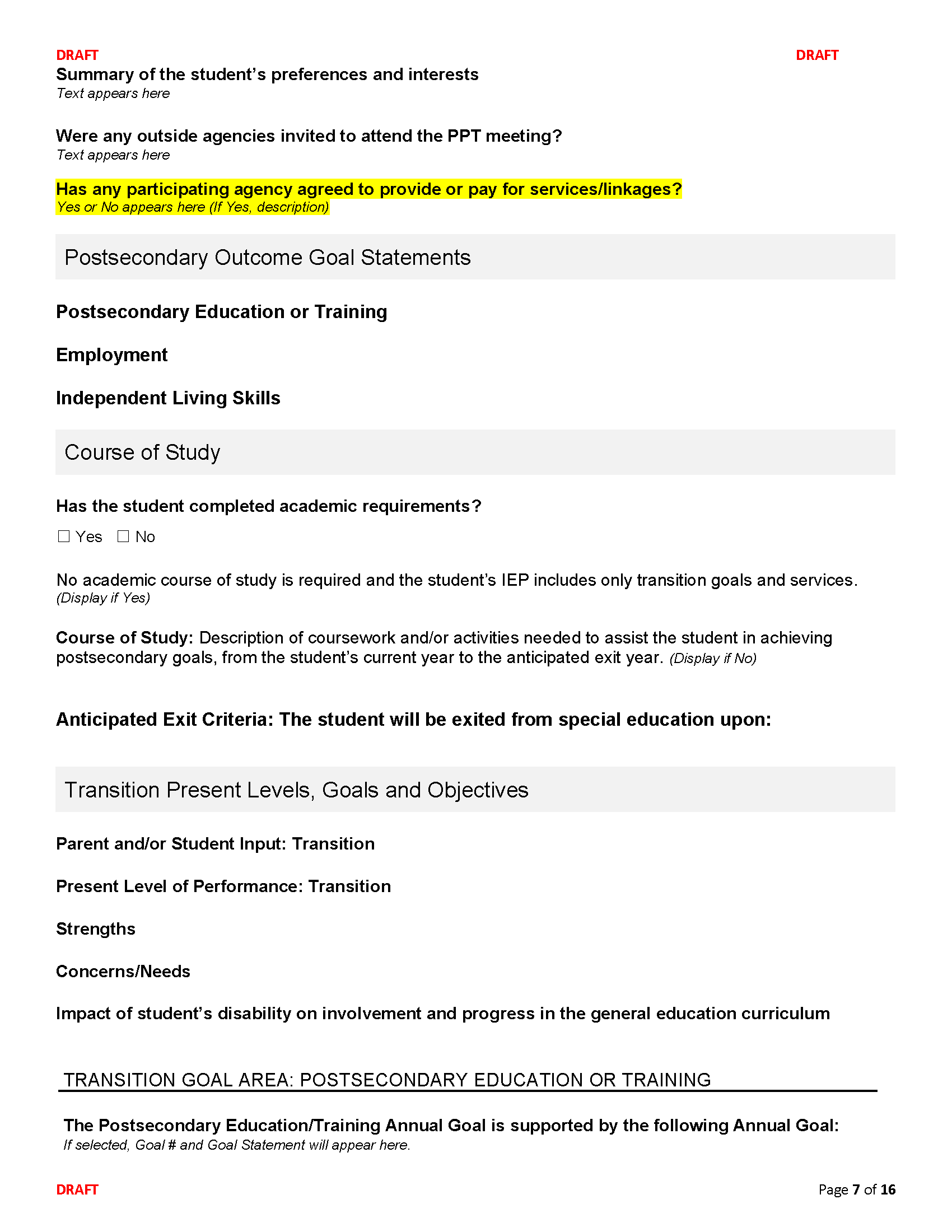
Outside Agencies
First, it is important to note that not all students need the involvement of outside agencies. As transition planning begins, the focus expands beyond the school environment. We start to consider post-secondary aspirations, including further education, employment, and independent living. To ensure a holistic approach, sometimes outside agencies that can offer specialized support and services tailored to a student's post-school life are involved.
Outside agencies often have a wealth of resources and expertise that can be pivotal in enhancing a student's transition plan. They may provide:
Vocational Training and Support: Helping students gain the skills needed for particular jobs or careers.
Post-secondary Education Guidance: Assisting students in navigating the transition to colleges, universities, or vocational schools.
Independent Living Skills Training: Offering guidance on essential life skills, from managing finances to using public transportation.
Community Participation and Social Integration: Connecting students to recreational activities or social groups that align with their interests.
The inclusion of outside agencies is always done with the full knowledge and consent of the parents or guardians. Before any agency is invited to a PPT meeting, the school must inform and obtain permission from the parents or guardians. This ensures transparency and respect for the student's and family's privacy.
Agency paying?
"Has any participating agency agreed to provide or pay for services/linkages?" seeks to identify and document if any of these agencies have formally committed to offering specific services or funding to aid the student's transition. This can encompass a myriad of things, including:
Vocational Training: An agency might fund or provide hands-on training programs for students interested in particular trades or professions.
Educational Assistance: Some agencies offer scholarships, grants, or mentoring programs to help students pursue further education.
Life Skills Programs: Certain agencies specialize in equipping students with essential life skills, like budgeting or navigating public transportation.
Employment Linkages: Agencies may have partnerships with businesses and can assist in providing job placements or internships for students.
Securing an agreement from an agency is like having an added layer of support. It not only offers the student access to specialized resources but also ensures continuity of care as they transition from school to their post-secondary endeavors.
Postsecondary Outcome Goal Statement
Think of these statements as the long-term vision for a student's journey after high school. They encapsulate the student’s ambitions concerning higher education, vocational training, employment, and in some cases, independent living scenarios.
These statements provide a clear window into the student's aspirations. They act as beacons, directing all the actions and plans that follow. Essentially, they are the 'big picture' dreams we aim to support. Every student has a unique path. These statements ensure that the IEP transition plan aligns perfectly with the individual needs and aspirations of the student.
A statement could look something like:
"Following graduation, [Student's Name] is enthusiastic about joining a technical institute to pursue automotive engineering." This leans towards an education/training goal.
"Post high-school, [Student's Name] is keen on exploring opportunities in the local art community, potentially leading workshops or selling original pieces." This indicates an employment aspiration.
"In the next five years, [Student's Name] wishes to master skills that allow them to live independently, managing personal finances, household tasks, and community involvement." This speaks to independent living goals.
While these statements are rooted in the student's dreams, their formulation is a team activity. The student, parents, teachers, and other specialists all provide their inputs, ensuring the statements are both inspiring and grounded in reality.
A student’s dreams and ambitions can shift over time. That's natural! Therefore, these Post-Secondary Outcome Goal Statements can and should be reviewed and adjusted as needed.
Active participation from both students and parents in shaping these statements is invaluable. Your unique perspectives, combined with the expertise of educators and specialists, create a well-rounded vision.
Course of Study
At its core, the "Course of Study" outlines the academic and vocational courses your child will engage in during high school to best prepare them for life after graduation. It's like the curriculum roadmap tailored to align with their post-secondary goals.
Transition Present Levels, Goals, and Objectives
This is where you put all those transition assessments to work!
Postsecondary Education or Training
Note your child's IEP must have a Postsecondary or Training goal AND an Employment Goal. Independent Living goals are based on a student's individual needs.
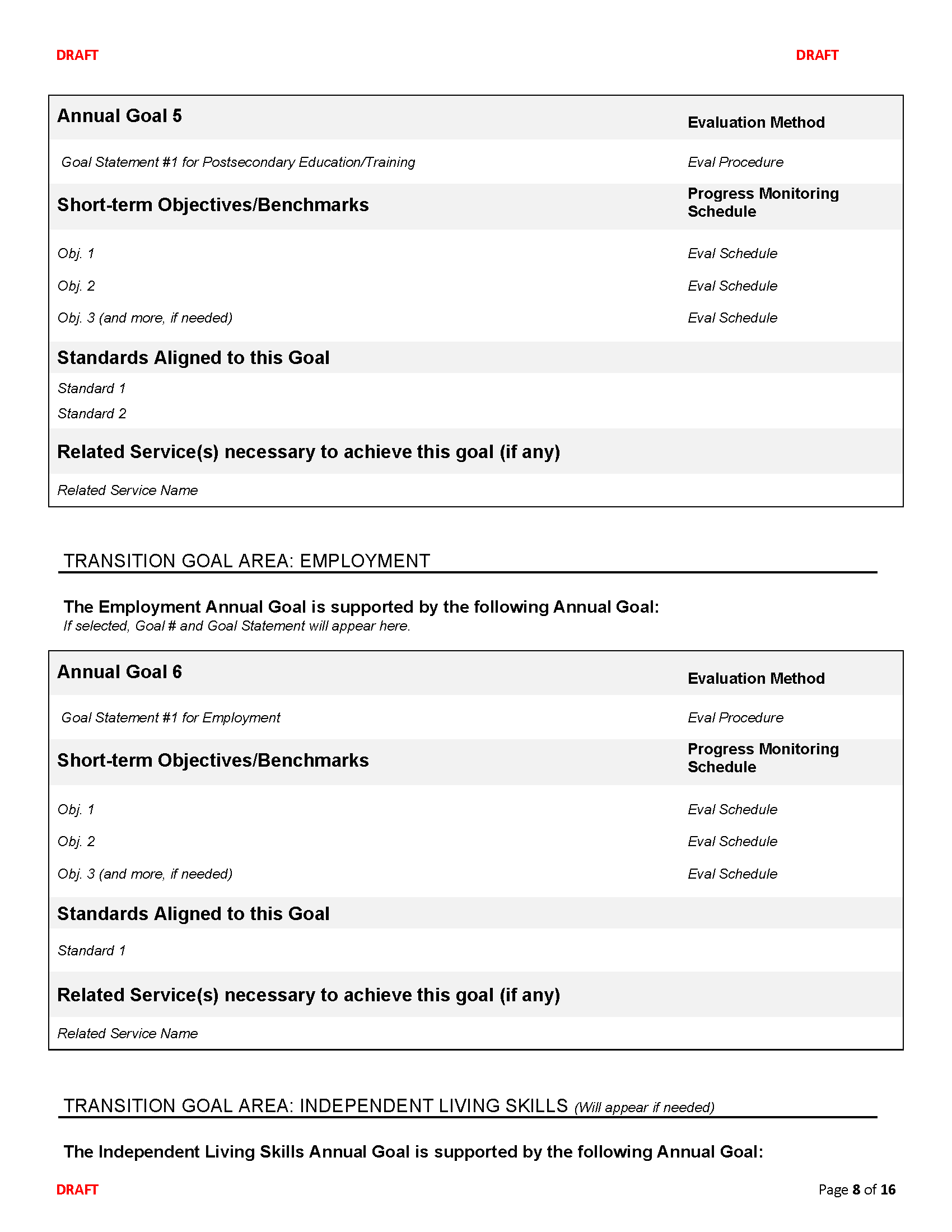
Employment
Note your child's IEP must have a Postsecondary or Training goal AND an Employment Goal. Independent Living goals are based on a student's individual needs.
Independent Living Skills
Note your child's IEP must have a Postsecondary or Training goal AND an Employment Goal. Independent Living goals are based on a student's individual needs.
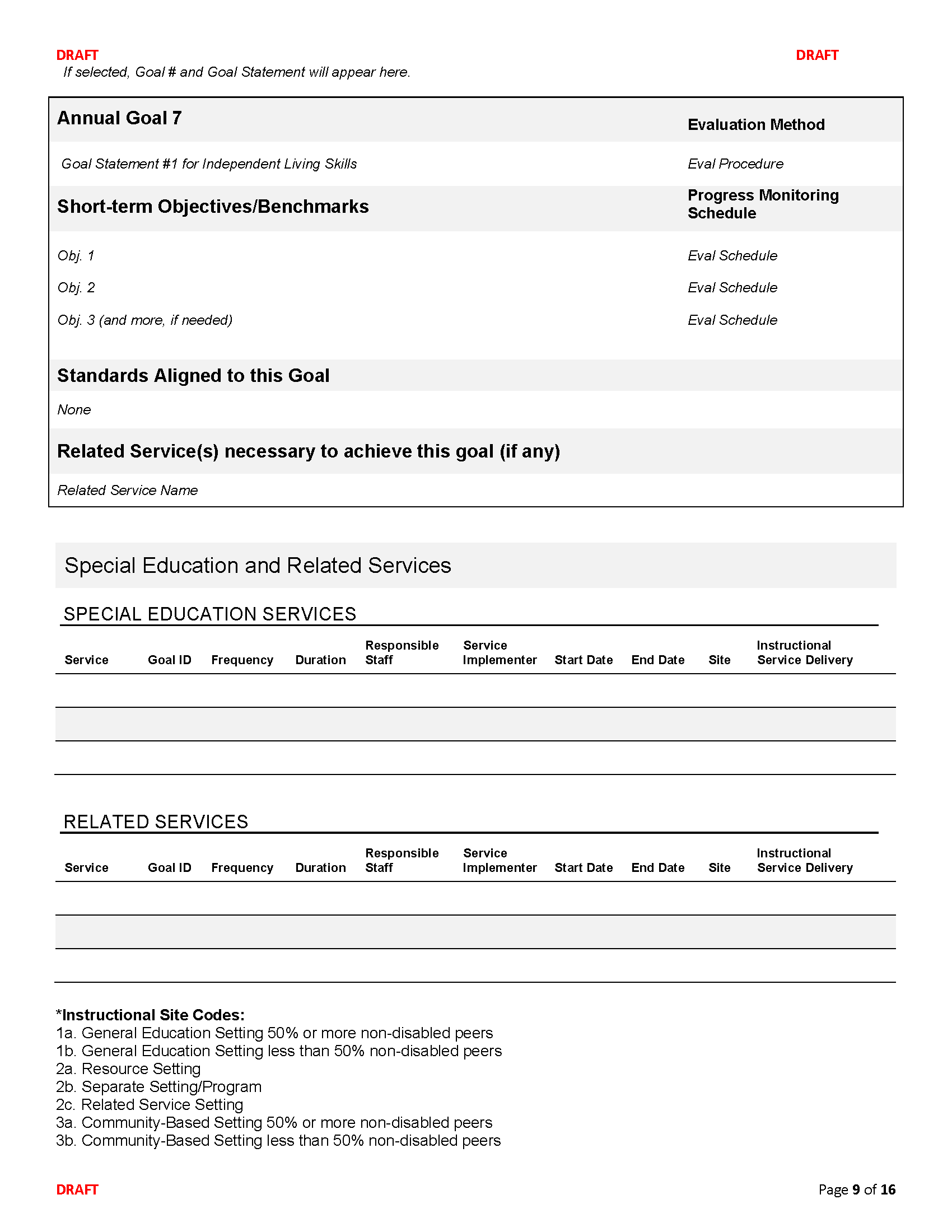
Special Education and Related Services
Now this is the old service grid. I don't know if it will make it easier to calculate the hours so they match the school schedule and rotation (sometimes the most difficult part of the IEP meeting) but other than it's no longer a grid, not much has changed here. Both special education and related services are integral parts of the journey, each playing a vital role in ensuring that students with disabilities can effectively navigate the educational landscape. It's through the strategic combination of these services that we're able to create an effective IEP for each student.
Both special education and related services are integral to the IEP, each playing a vital role in ensuring that students with disabilities can effectively navigate their educational landscape.
Services
Special education services are how your child's IEP is implemented. They are designed to meet the unique needs of a child with a disability, primarily focusing on providing instruction that is tailored to the child's needs. This might include adaptations in content, teaching strategies, or instructional delivery methods. For example, a special education service could be one-on-one reading instruction for a child with dyslexia or modified instruction in math for a child with an intellectual disability.
Related Services
On the other hand, related services are like bridges and tunnels that aid our journey, allowing us to reach our destination more smoothly. They support the child's access to and benefit from special education. Related services can include speech-language pathology, occupational therapy, physical therapy, counseling services, and transportation, among others. These services are typically provided by professionals like speech therapists, psychologists, and physical therapists to help the child overcome barriers that their disability might present in the educational setting.
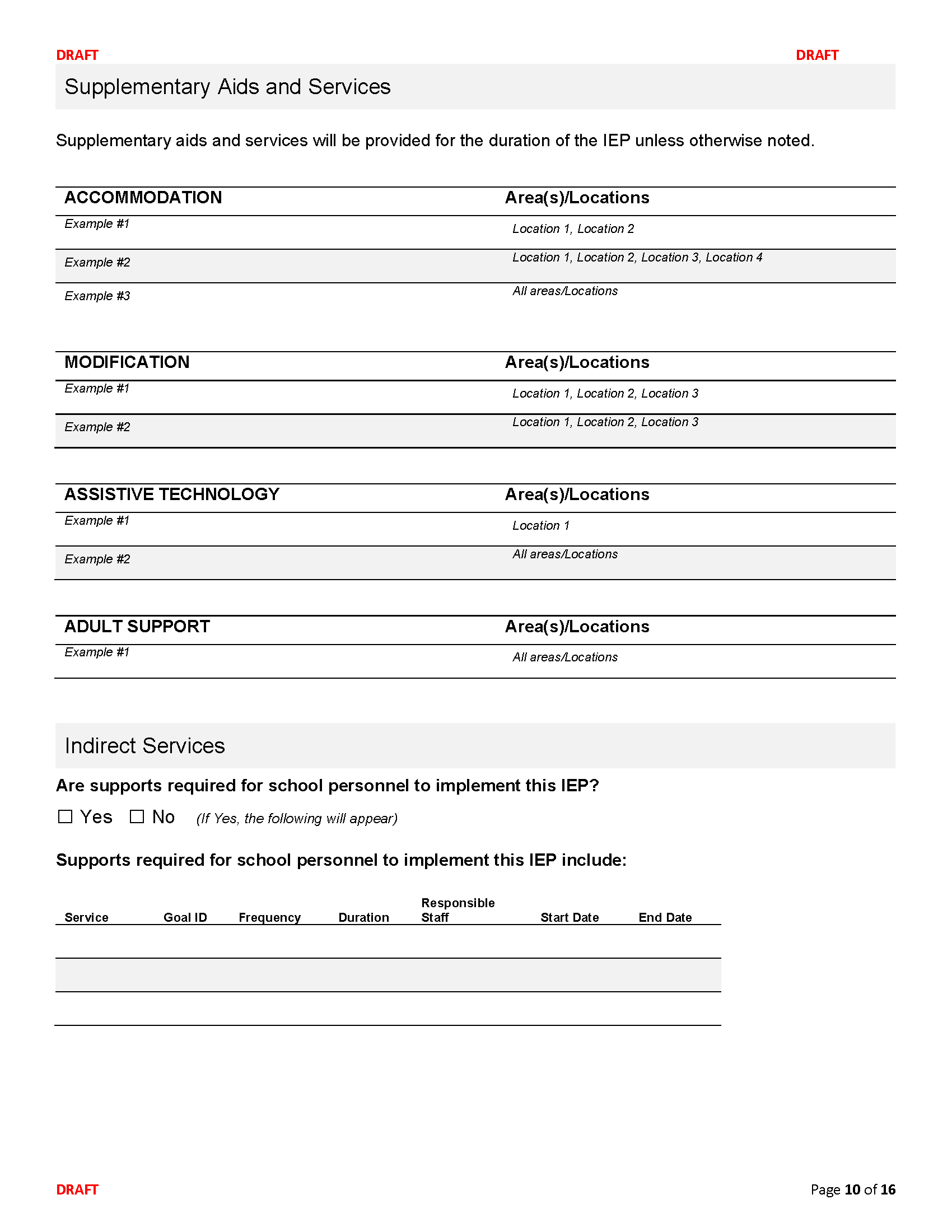
Supplementary Aids and Services
Supplementary Aids and Services play a pivotal role in supporting students with disabilities within mainstream classrooms and school settings.
Think of these as specialized tools designed to ensure students receive the necessary support to thrive academically. They can include curriculum modifications, adjustments in teaching methods, or even social-emotional support, tailored to fit each student's unique needs.
In essence, Supplementary Aids and Services are essential components of an IEP, aimed at making education more inclusive, accessible, and beneficial for every student.
Accommodations
Accommodations are adjustments to how tasks or assessments are presented, allowing students with disabilities to access the same content as their peers without altering the content itself. This is distinct from modifications, which involve changes to the content or learning expectations.
Examples of accommodations might include:
Modifications
Modifications involve changes to the content, curriculum, or learning expectations to meet the specific needs of a student with disabilities. This is distinct from accommodations, which adjust how tasks or assessments are presented without altering the content itself.
Here are some examples of modifications:
Reduced Assignments: Instead of completing 20 math problems, the student might be expected to complete 10.
Simplified Readings: Instead of reading a grade-level text, the student might read a simplified version that presents the same content but at a lower reading level.
Alternative Projects: Instead of writing a lengthy report, the student might create a visual presentation or a shorter summary.
Different Questions: Instead of answering higher-order, critical thinking questions, the student might answer more basic comprehension questions.
Adjusted Grading Scale: Instead of being graded on the standard scale, the grading criteria might be altered to emphasize effort, improvement, or participation.
Use of Different Materials: Instead of the regular class textbook, a student might use one that is written in simpler language.
Content Prioritization: Instead of covering all topics in a unit, a student might focus only on the key concepts.
Remember, modifications differ from accommodations in that they change the actual content or expectations, whereas accommodations change the manner in which content is presented or accessed.
Assistive Technology (AT)
Assistive technology refers to devices, software, or equipment that help students with disabilities access the curriculum and participate fully in the learning process. AT can range from simple tools, like magnifying glasses or pencil grips, to more complex solutions, such as speech-to-text software or specialized keyboards. The primary goal is to bridge the gap between the student's abilities and the classroom demands, ensuring an equitable learning experience. The specific technology chosen should cater to the individual needs of the student, enhancing their ability to learn, communicate, and engage effectively in their educational environment.
Adult Support
Adult support refers to the assistance provided by an additional staff member or professional to help a student with disabilities access their education and participate in school activities. This could encompass one-on-one aides, job coaches, interpreters, or therapeutic staff. Their role can be diverse, ranging from helping with academic tasks, facilitating social interactions, ensuring safety, or providing specialized instruction in specific skills. The intention is to address the individual needs of the student, allowing them to benefit fully from their educational environment. The specific type and level of adult support should be tailored to the student's unique requirements, ensuring they can thrive both academically and socially.
Indirect Services
Indirect services refer to specialized support and guidance that educators, therapists, or other professionals provide to school staff or family members to benefit the student with disabilities. Rather than working directly with the student, these services are delivered behind the scenes to bolster the student's learning environment. Examples might include training teachers on specific teaching methods, advising on behavioral strategies, consulting on curriculum adaptations, or providing families with strategies to support learning at home. The aim of indirect services within the IEP is to ensure that everyone involved in the student's education is well-equipped with the knowledge and tools necessary to facilitate optimal learning and development for the student. The nature and frequency of these services will depend on the student's needs and the goals outlined in the IEP.
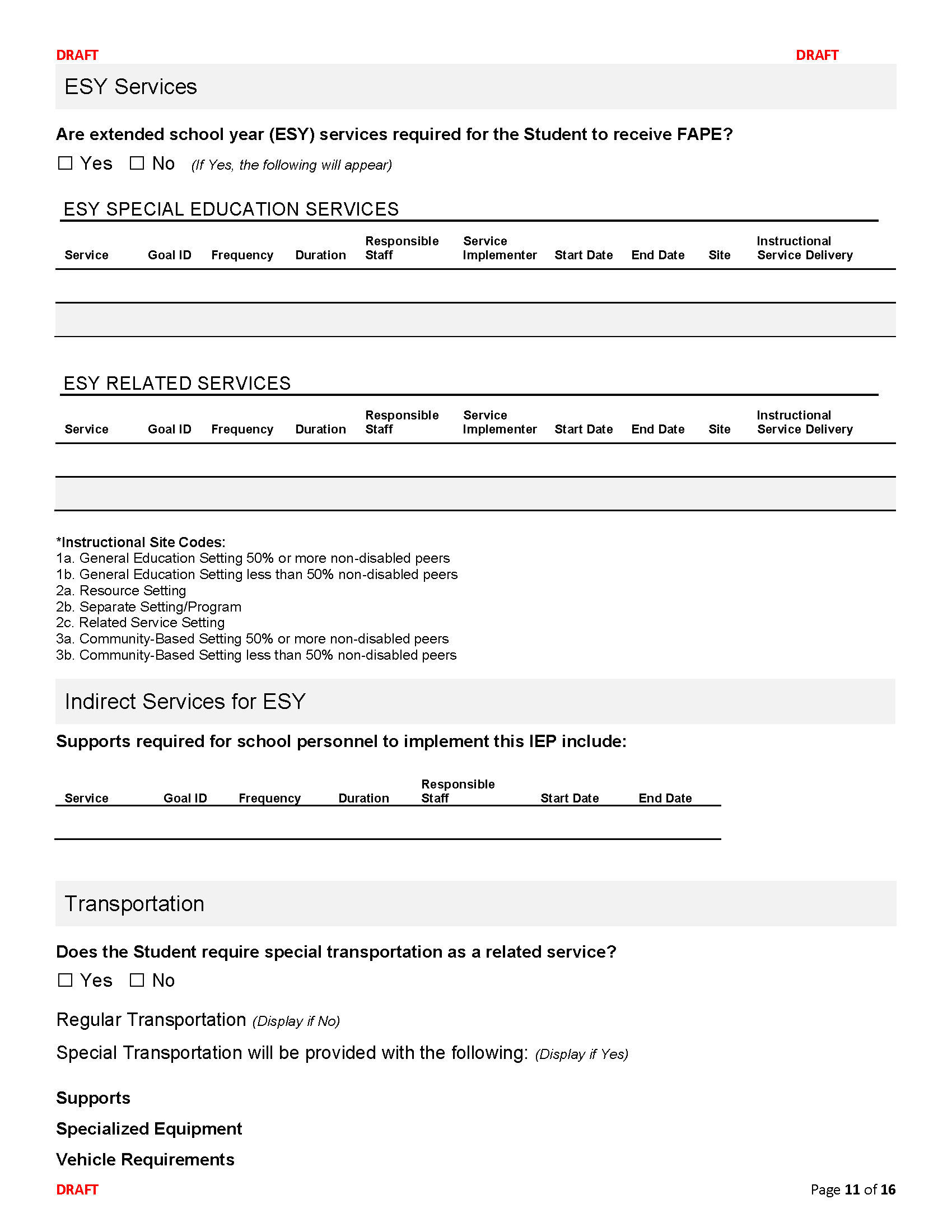
Extended School Year (ESY) Services
ESY, or Extended School Year, refers to special education and related services provided beyond the regular school year. Its purpose is to support students with disabilities in maintaining their skills and not regressing during breaks like summer vacation. Not all students qualify for ESY; eligibility is determined by the student's Individualized Education Program (IEP) team based on various factors, including the severity of the disability, the likelihood of skill regression, and the time it may take the student to recoup lost skills. ESY services are tailored to the individual needs of the student and may vary in duration, type, and intensity. The goal of ESY is to ensure continuous progress and prevent significant skill or knowledge loss during extended breaks.
Transportation
Transportation within an IEP refers to the provision of travel assistance to and from school and between schools for students with disabilities. It's considered a related service, ensuring students receive their entitled educational services. Depending on a student's specific needs, this might mean specialized vehicles, equipment, or accommodations. For some students, this could be as straightforward as a seat on a regular bus. For others, it might involve a wheelchair-accessible vehicle or additional supervision during transit. The IEP team determines the necessity and specifics of transportation based on the unique needs of the student, ensuring safe and effective transit aligned with the student's educational objectives.
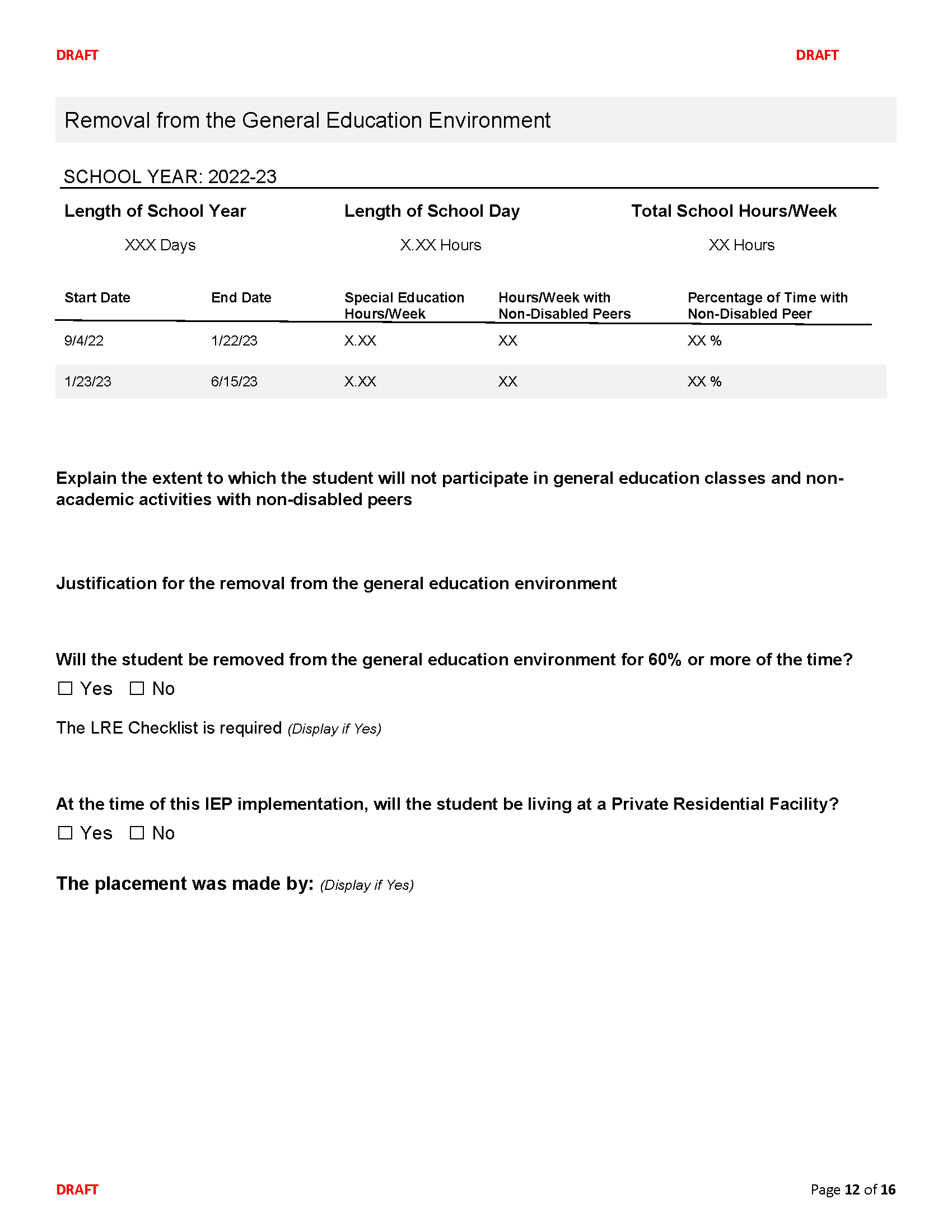
Removal from the General Education Environment
Removal from the General Education Environment refers to instances where a student with disabilities is educated outside of the regular classroom setting for part or all of the school day. This decision is based on the student's specific needs and is only made when the nature or severity of the disability is such that education in regular classes, even with the use of supplementary aids and services, cannot be achieved satisfactorily. It is always the goal of the IEP team to educate students in the least restrictive environment, ensuring they spend as much time as possible with non-disabled peers. However, in cases where specialized instruction or environments are necessary for the student's success, temporary or partial removal might be considered. It's essential to note that any decision to remove a student from the general education environment is made with careful consideration, always prioritizing the student's best interests and educational needs.
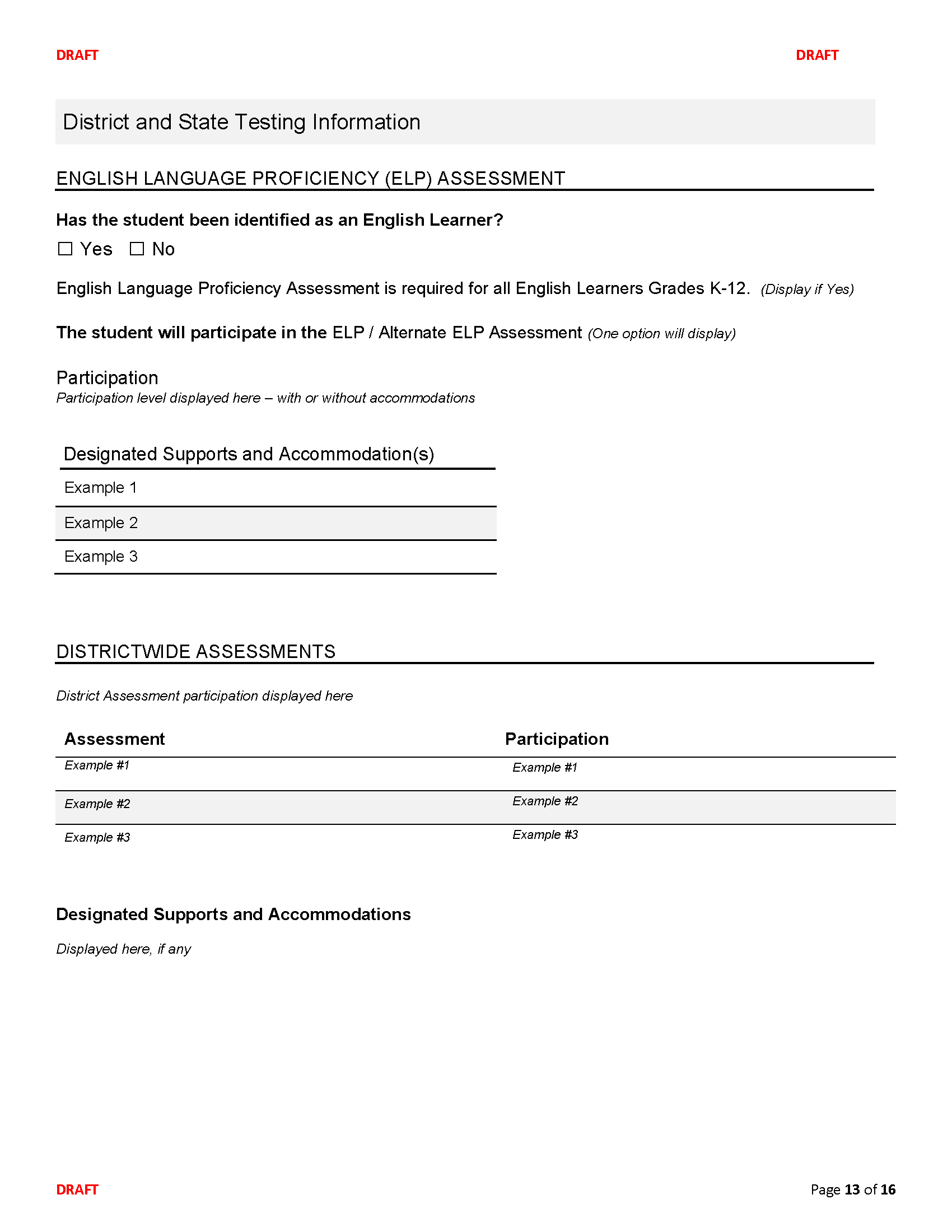
District and State Testing Information
District and State Testing Information within the IEP pertains to the standardized assessments that students participate in throughout their educational journey. For students with disabilities, it's crucial to determine how they will participate: whether they'll take the test with or without accommodations, or if an alternative assessment is more appropriate. This section of the IEP outlines any accommodations the student may need, such as extended time or a quiet testing environment. It ensures that students have equitable access to showcase their knowledge without being hindered by their disabilities.
Additionally, the IEP will specify if the student requires an alternate assessment, designed to be more suitable for their learning needs.
Making informed decisions in this area is vital, as these tests often play a role in tracking academic progress, graduation requirements, and post-school planning. The goal is always to provide an assessment experience that is both fair and reflective of the student's true capabilities.
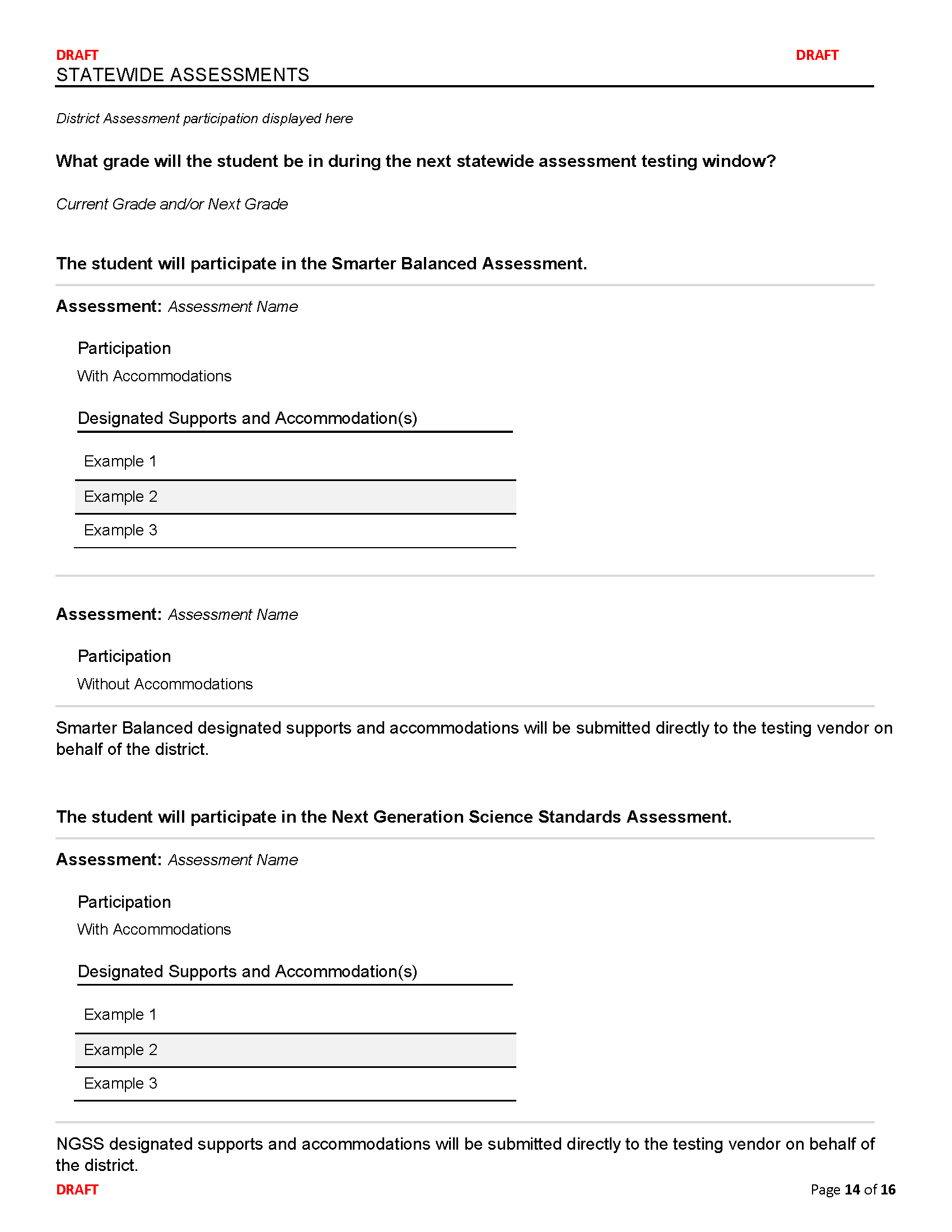
Can you get College Board accommodations if you don't have IEP accommodations?
In short, yes, a student can obtain accommodations for College Board exams even if those accommodations are not specified in their IEP or 504 Plan. However, there are several important points to consider:
Documentation: College Board requires comprehensive documentation that clearly shows why the accommodation is necessary. This might include evaluations from professionals, evidence of the student's disability, and a history of the use of the accommodation in other settings (e.g., classroom tests).
Consistency of Need: While having the accommodation listed in an IEP or 504 Plan can make the approval process smoother, what College Board is primarily looking for is evidence of a consistent need. For instance, if a student doesn’t have extended time in their IEP but has a well-documented history of receiving (and needing) extended time for classroom tests and other exams, this can be used to support their request.
School’s Role: Typically, the school's SSD (Services for Students with Disabilities) Coordinator submits the request for accommodations to the College Board. Even if an accommodation isn't in the student's IEP, if the school is supportive and can provide evidence for the need, they can still submit a request on behalf of the student.
Timing: It's crucial to start the request process early. Evaluations, gathering documentation, and the review process can take time. Starting early ensures that if there are any issues or additional information needed, there’s ample time to address them before test day.
Review Each Case Individually: College Board reviews each accommodation request on a case-by-case basis. Just because one student receives a particular accommodation doesn't guarantee another student will receive the same, even if their situations seem similar.
In summary, while having accommodations listed in an IEP or 504 Plan can provide strong supporting evidence, it's not the sole determining factor. The key is to demonstrate a consistent need for the requested accommodation based on the student's disability.
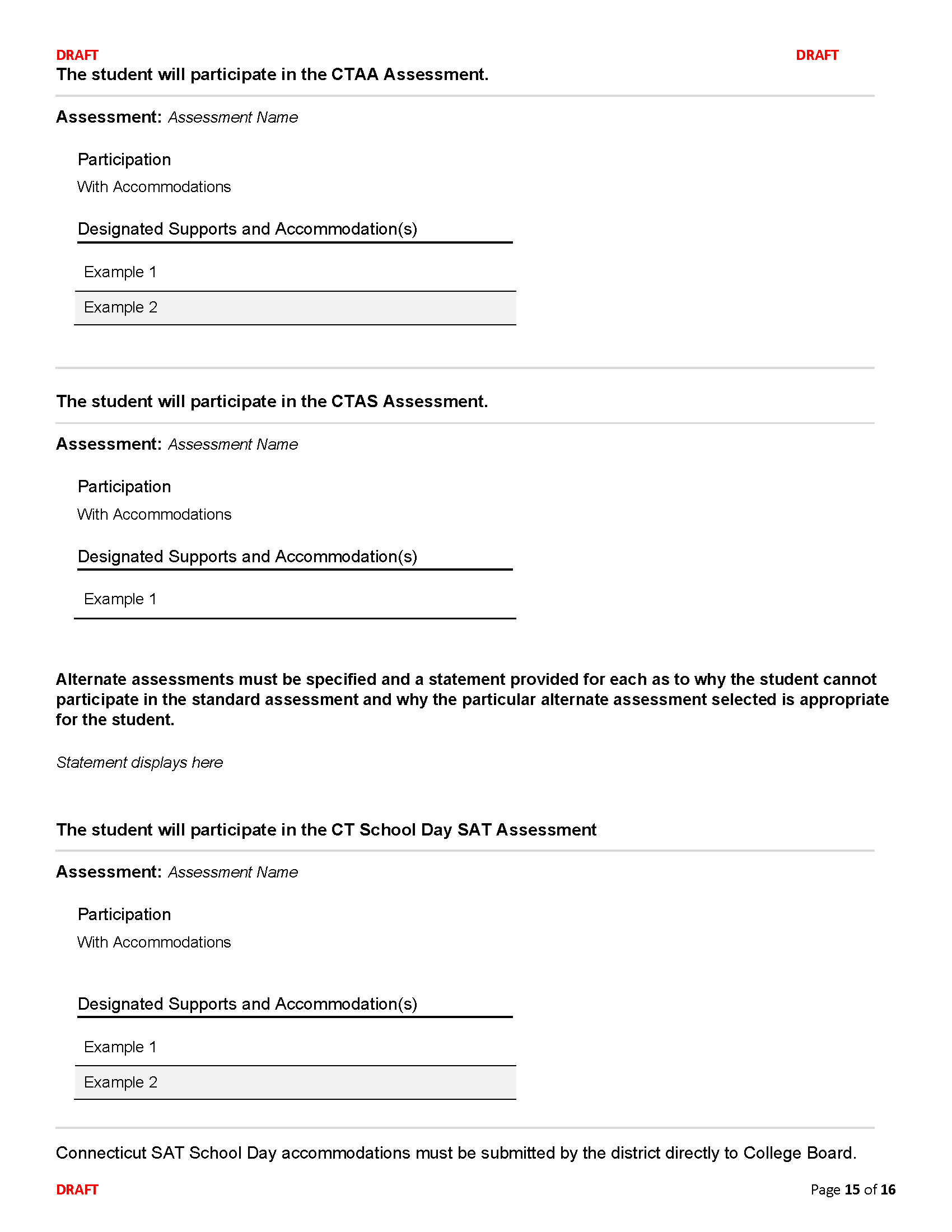
Alternative Assessments
Alternate assessments are specialized tests developed for students with the most significant cognitive disabilities and are designed to measure their academic progress in a way that is appropriate for their abilities. When an IEP team determines that a student cannot participate in standard district or state assessments due to their unique needs, an alternate assessment may be considered. Here are the two items that need to be addressed:
Rationale for Non-Participation in Standard Assessments: It is crucial to clarify why a student is unable to take the standard assessment. This ensures that the decision is based on the student's individual needs and not on other factors, such as the desire to improve overall test scores for the school.
Justification for the Chosen Alternate Assessment: Not all alternate assessments are the same, and the chosen one should align with the student's educational needs and learning goals. By providing a statement that explains why a particular alternate assessment is appropriate, it ensures the test is a valid measure of the student's progress and abilities.
Remember, the goal is to have a testing approach that fairly and accurately measures a student's academic progress. It's about ensuring that every student, regardless of their abilities, has an equitable opportunity to demonstrate their learning

Transfer of Rights
When a student receiving special education services reaches the age of majority (typically 18 in most states, unless otherwise specified), the rights previously held by the parents or guardians under the IDEA transfer to the student. This is a transition that recognizes the student's legal adulthood and capacity to make decisions regarding their education. At this point, it is the student who will make all the decisions.
If however, your child would like you to continue to make the decisions, they can give you an educational power of attorney.
Progress Reporting
Progress Reporting serves a crucial role in tracking and communicating a student's advancement towards their established annual goals. Here's a quick breakdown:
Purpose: It provides parents, guardians, and relevant educators with regular updates on the student's progress, helping all parties to understand how well the interventions and supports are working.
Frequency: Progress reports are typically issued at the same frequency as regular report cards—often quarterly. However, the exact timing can be outlined in the IEP.
Content: These reports offer specific information about the student's advancement (or challenges) in relation to the goals set within the IEP. They might include data, teacher observations, or other relevant insights.
Adjustments: Based on progress reports, IEP teams can make informed decisions, whether it's celebrating successes or identifying areas where additional support might be necessary.
Remember, the ultimate aim is ensuring that the student receives the support and resources they require to succeed. Progress reporting acts as a valuable tool in that journey, offering clarity and direction for everyone involved.
Resources
The Resources section at the end of the IEP is a valuable component that lists and additional information and support for both educators and families that was provided at the IEP meeting.
Resources provided are typically tools, references, and contacts that can enhance the student's educational experience and aid in implementing the IEP effectively.
It could include:
As resources evolve and new ones emerge, this section might be updated to ensure the most relevant and beneficial tools are at the fingertips of those involved.
DISCLAIMER: The materials on this website are for attorney advertising and are not intended to establish an attorney-client relationship between you and the Law Offices of Dana A. Jonson, LLC. Please note that an attorney-client relationship with the Law Offices of Dana A. Jonson, LLC is only established upon the execution of a retainer agreement. Do not send confidential documents without receiving express prior approval. The content on this website is provided for entertainment purposes only and should not be construed as legal advice. Any external links are provided for informational purposes only, and the Law Offices of Dana A. Jonson, LLC is not responsible for the accuracy or content of linked materials.